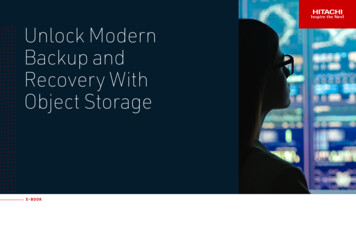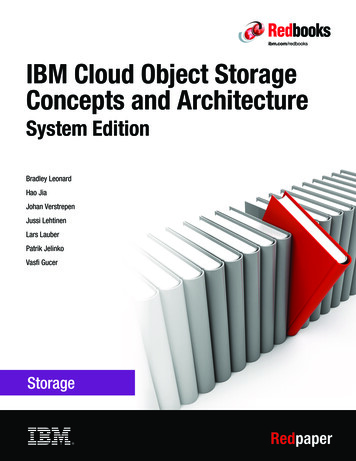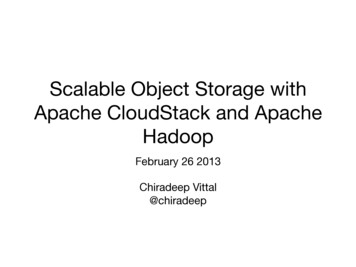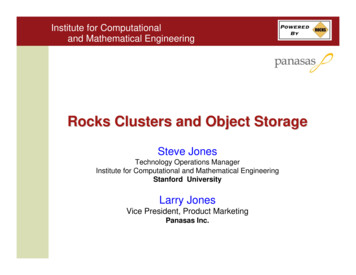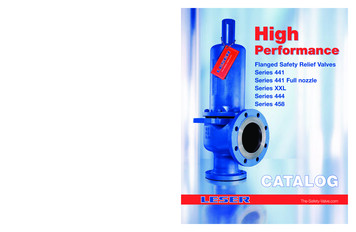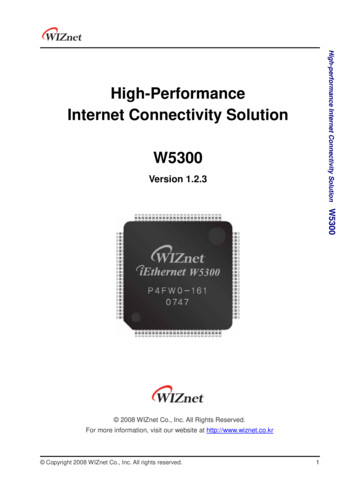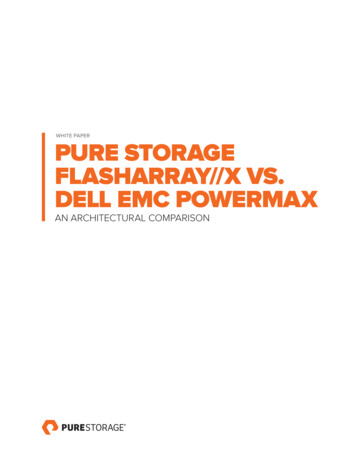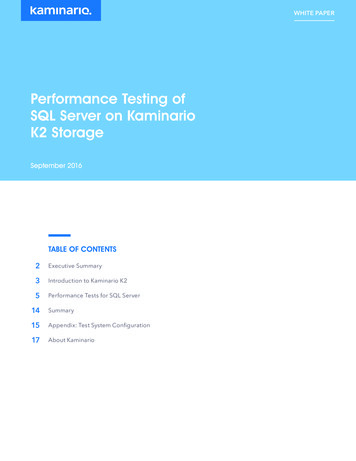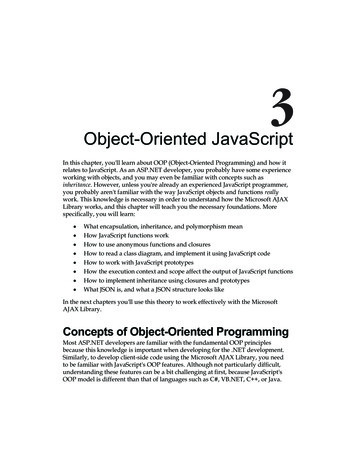
Transcription
High PerformanceObject StorageWHITE PAPER
Executive SummaryMinIO is a high performance, distributed object storage system. By following the methods anddesign philosophy of hyperscale computing providers, MinIO delivers superior performance,resilience and scalability to a wide variety of workloads in the private cloud, public cloud,Kubernetes distributions and edge. This makes MinIO the standard for hybrid cloud architectures.While MinIO is ideal for traditional object storage use cases like secondary storage, disaster recoveryand archiving, it truly excels in overcoming the challenges of delivering massive primary storageacross a range of use cases from Kubernetes-powered cloud applications to AI/ML/advancedanalytics workloads.Because MinIO is purpose-built to serve only objects, a single-layer architecture achieves all ofthe necessary functionality without compromise. The advantage of this design is an object serverthat is high-performance and lightweight: efficient enough to run in a container and powerfulenough to become the core of a Kubernetes-managed object storage as a service platform.MinIO is a pioneer in the development of cloud-native object storage, refining and perfecting manyof the features, protocols and APIs that have come to define best in class. This is evidenced bythe more than 530M Docker pulls, 26K GitHub stars and thousands of production deploymentsacross every continent.This paper details the philosophical approach and technical attributes of MinIO and why thoseattributes are important to any enterprise seeking to develop or migrate to an object storagecentric, microservices architecture across the public and private cloud.High Performance Object Storage02
The Enterprise ChallengeHow enterprises store, access, move and analyze data is undergoing massive change. Driven bythe storage and compute efficiencies made possible by disaggregation, enterprises are findingthat their investments in traditional storage solutions like Hadoop HDFS are now obsolete. Thesecret of elite hyperscalers, disaggregation, offers multiple benefits, but the two largest areeconomics and performance. As a result, enterprises are rearchitecting their data infrastructuresto take advantage of this separation.Figure 1: The modern, disaggregated architectureThe reasons are straightforward. File and block protocols are complex, have legacy architecturesthat impede innovation, are limited in their ability to scale or are compromised from aperformance perspective. Examples of these limitations include the aforementioned aggregationof compute and storage but also include replication, security, encryption and data mobility.The winner in this transformation is cloud-native object storage.Storage as a Service or STaaS is the second-fastest growing cloud workload worldwide, representinga USD 19.9 billion annual market in 2020 and projected to grow to USD 101.9 billion in 2027. Datais growing exponentially every year and by 2025, experts predict that the world will create andreplicate 163 zettabytes (ZB) of data. The vast majority of that will be unstructured orsemi-structured.Fueling that growth is a focus on big data applications, primarily analytics and artificialintelligence (AI) workloads on Internet of Things (IoT) and other event data. These workloadsdemand high rates of throughput, excellent data integrity and a cost-effective deployment model.High Performance Object Storage03
Simple, powerful and with unlimited scalability, modern object storage has moved out of backupand into the application and analytic workflow. A reduced set of storage APIs, accessed overHTTP RESTful services mean that these cloud-native solutions are lightweight enough to bepackaged with the application stack to be run in containers orchestrated by Kubernetes.Figure 2: The advantages of modern object storageThe Philosophy Of The CloudMinIO combines the inherent advantages of object storage with a robust suite of features, astunningly simple, intuitive interface and an expansive set of integrations.MinIO is unique in that it was built from the ground up with cloud-native technologies to besimple, fast, durable and highly scalable. With the belief that a complex solution cannot bescalable, a minimalist design philosophy forms the foundation of the MinIO architecture.The result is a system that excels across several key dimensions:Performance. With its focus on high performance, MinIO enables enterprises to supportmultiple use cases with the same platform. For example, MinIO’s performance characteristicsmean that you can run multiple Apache Spark, Presto/Trino and Apache Hive queries, or toquickly test, train and deploy AI algorithms, without suffering a storage bottleneck. MinIOprovides a high-performance object-storage back end to streaming data analytics. MinIO objectstorage is used as the primary storage for cloud native applications that require higherthroughput and lower latency than traditional object storage can provide. High Performance Object Storage04
Scalability. A design philosophy that “simple things scale” means that scaling starts with asingle pool (an independent set of compute, network and storage resources) which can becombined with other MinIO pools to expand the capacity per deployment. In multi-tenantconfigurations, each tenant is a cluster of server pools that are fully isolated from each other intheir own namespaces. Expansion of the namespace is achieved by adding more clusters andracks within a data center, at the edge, or in a public, private or hybrid cloud. Simplicity. Minimalism is a guiding design philosophy at MinIO. Simplicity reduces opportunitiesfor errors, improves uptime and delivers reliability while serving as the foundation forperformance. MinIO can be installed and configured within minutes from our intuitive graphicaluser interfaces or our simple command line interface. The amount of configuration options andvariations is kept to a minimum, resulting in near-zero system administration tasks and very fewpaths to failure. Upgrading MinIO is done with a single command which is non-disruptive andincurs zero downtime - lowering total cost of ownership. Collectively, these philosophical pillars enable MinIO to seamlessly deliver multi-instance,multi-tenant object storage across any hardware and to any workload. That means MinIO canrun anywhere Kubernetes runs, from VMware’s Tanzu to AWS itself and everywhere in between.High Performance Object StorageEvery feature of MinIO’s object storage suite was architected to deliver performance, scale andresiliency. As a software-defined solution, MinIO can be paired with hundreds of differentcompute and storage configurations from Intel Cascade Lake, ARM Graviton, or Atom processorson the compute side to Optane and NVMe SSDs and traditional spinning eNVMeNVMeNVMeNVMeNVMeNVMeNVMeNVMeNVMeNVMeFigure 3: A typical MinIO deployment.MinIO’s software defined object storage suite consists of a server, and optional components suchas a client, a management console, a Kubernetes Operator and Operator Console and asoftware development kit (SDK):High Performance Object Storage05
MinIO ServerMinIO is a distributed object storage server. It boasts the most comprehensive implementationof the Amazon S3 API to be found anywhere outside of Amazon itself. MinIO is feature-complete,providing enterprise-grade encryption, identity management, access control, and data protectioncapabilities, including inline erasure code, bitrot protection, immutability, active-active replicationand other features.MinIO ClientCalled mc, the MinIO Client is a modern and cloud-native alternative to the familiar UNIXcommands like ls, cat, cp mirror, diff, find and mv. This client provides advanced functionality thatis suitable for web-scale object storage deployments. For example, powerful data replicationtools work between multiple sites for HA (highly availability) and DR (disaster recovery) purposesand support generating shared, time-bound links for objects. Further, extensive scriptingcapabilities enable automation for DevOps teams.MinIO ConsoleThe MinIO Console is a browser-based GUI that incorporates all the functionality of MinIO Clientin a design that feels familiar for IT admins and developers alike. Built to support cloud-scaledeployments with minimal operational overhead, MinIO Console enables administrators and usersto provision multi-tenant object storage as a service, visually inspect the health of the system,perform key audit tasks and simplify integration (via webhooks and API) with other components.Figure 4: MinIO Console streamlines object storage operations with a full-featured GUI.High Performance Object Storage06
MinIO Kubernetes OperatorMinIO Kubernetes Operator adds a plugin to the Kubernetes CLI that allows DevOps teams todeploy and manage MinIO object storage on Kubernetes. A straightforward list of commandsmakes it easy to execute MinIO’s key capabilities. Actions can be scripted and automated,making it easy to deploy and consume object storage within the DevOps and Kubernetes-centricworld.Kubernetes Operator ConsoleMinIO Kubernetes Operator Console provides a graphical user interface (GUI) that makes it eveneasier to create, deploy and manage muti-tenant, object storage as a service to internal andexternal stakeholders alike.Figure 5: MinIO Kubernetes Operator Console is an essential component of object storage as a service.MinIO SDKsThe MinIO Client SDKs provide simple APIs to access any Amazon S3-compatible object storage.MinIO repositories on Github offer SDKs for popular development languages such as Go,JavaScript, .Net, Python and Java.The features of MinIO’s Object Server are notable for their breadth, depth and focus on theenterprise. As a cloud-native implementation, the range of features exceed those in legacy or bolt-onimplementations while the attention to engineering-first principles ensure exceptional performance.High Performance Object Storage07
Key FeaturesMinIO only does object storage and as a result, has a broad range of features that are designedto create a persistence layer that is performant, resilient, secure and scalable across the hybridcloud.S3 SelectTo deliver high-performance access to big data, analytic and machine learning workflowsrequires server-side filtering features - also referred to as “predicate pushdown”.MinIO has developed a SIMD accelerated version of the S3 Select API which is essentially SQLquery capabilities baked right into the object store. Users can execute SELECT queries on theirobjects, and retrieve a relevant subset of the object, instead of having to download the wholeobject. With the S3 Select API, applications can now download a specific subset of an object only the subset that satisfies the given SELECT query. This directly translates into efficiency andperformance by reducing bandwidth requirements, optimizing compute and memory resourcesmeaning more jobs can be run in parallel - with the same compute resources. As jobs finishfaster, there is better utilization of analysts and domain experts. This capability works for objectsin CSV, JSON and Parquet formats and is effective on compressed objects as well.Erasure CodingMinIO protects data with per-object, inline erasure coding which is written in assembly code todeliver the highest performance possible. MinIO uses Reed-Solomon code to stripe objects intodata and parity blocks - although these can be configured to any desired redundancy level. Thismeans that in a 12 drive setup with 6 parity configuration, an object is striped across as 6 dataand 6 parity blocks. Even if you lose as many as 5 ((n/2)–1) drives, be it parity or data, you canstill reconstruct the data reliably from the remaining drives. MinIO’s implementation ensures thatobjects can be read or new objects written even if multiple devices are lost or unavailable.Erasure code protects data without the limitations of RAID configurations or data replicas. Forexample, RAID-6 only protects against a two-drive failure whereas erasure code allows MinIO tocontinue to serve data even with the loss of up to 50 percent of the drives and 50 percent of theservers. Replication results in 3 or more copies of the object on each of the sites. Erasure-codeoffers a significantly higher level of protection while only consuming a fraction of the storagespace as compared to replication.Finally, MinIO applies erasure code to individual objects, which allows the healing at an objectlevel granularity. For RAID-protected storage solutions, healing is done at the RAID block layer,which impacts the performance of every file stored on the volume until the healing is completed.High Performance Object Storage08
OBJECT1OBJECT2100 GBe SWITCHS3 APISERVER 1SERVER 2SERVER 3SERVER 32Figure 6: Erasure code protects data without the overhead associated with alternative approaches.BitRot ProtectionSilent data corruption or bitrot is a serious problem for drives resulting in the corruption of datawithout the user’s knowledge. As the drives get larger and larger and the data needs to persistfor many years, this problem is more common than we imagine. The data bits decay when themagnetic orientation flips and loses polarity. Even solid state drives are prone to this decay whenthe electrons leak due to insulation defects. There are also other reasons such as wear and tear,voltage spikes, firmware bugs and even cosmic rays.MinIO’s SIMD accelerated implementation of the HighwayHash algorithm ensures that it willnever return corrupted data - it captures and heals corrupted objects on the fly. Integrity isensured from end to end by computing hash on WRITE and verifying it on every READ from theapplication, across the network and to the memory/drive. The implementation is designed forspeed and can achieve hashing speeds over 10 GB/sec per core on Intel CPUs.Figure 7: MinIO’s data protection schemes cover failure and silent data corruption.High Performance Object Storage09
Identity and Access ManagementMinIO supports the most advanced standards in identity management, offering an interal IAMwhile also integrating with OpenID connect and LDAP compatible IDP providers.MinIO’s internal IAM approach employs the access key and secret key credential framework.Applications use those credentials to authenticate every time they perform operations on theMinIO cluster. Access policies are fine grained and highly configurable via API, which means thatsupporting multi-tenant and multi-instance deployments become simple.3IDENTITYPROVIDER(IdP)1APPLICATION425Figure 8: Identity protection and single sign on (SSO) are critical enterprise features.MinIO also supports leading third-party external identity providers (IDP). These standalonesystems specialize in the creation, authentication, and management of user identities. Currentlysupported vendors include Keycloak, Facebook, Google, Okta, Active Directory and OpenLDAP. Inaddition to internal and external user identities, the MinIO Console supports the creation ofService Accounts.On the Access Management side, MinIO controls the authorization of an authenticatedapplication, using AWS IAM-compatible Policy-Based Access Control (PBAC).EncryptionIt is one thing to encrypt data in flight and another to protect data at rest. MinIO supportsmultiple, sophisticated server-side encryption schemes to protect data - wherever it may be.MinIO’s approach ensures confidentiality, integrity and authenticity with negligible performanceoverhead. Server side and client side encryption are supported using AES-256-GCM,ChaCha20-Poly1305 and AES-CBC. Encrypted objects are tamper-proofed with AEAD serverside encryption. Additionally, MinIO is compatible with and tested against commonly used KeyManagement solutions (e.g. HashiCorp Vault).MinIO uses key-management-systems (KMS) or cryptographic key management system (CKMS)to support SSE-S3. If a client requests SSE-S3, or auto-encryption is enabled, the MinIO serverencrypts each object with a unique object key which is protected by a master key managed bythe KMS. Given the exceptionally low overhead, auto-encryption can be turned on for everyapplication and instance.High Performance Object Storage10
Figure 9: Encryption and WORM protect data in flights and at rest.Finally, MinIO has introduced its own Key Encryption Service (KES). Stateless and distributed(KES) was designed to be run inside Kubernetes and distribute cryptographic keys toperformance oriented applications. KES operates as a bridge between a central KMS andcloud-native applications, as an abstraction layer over different KMS vendors and as a scale-outload balancer for cryptographic operations in distributed systems.Data Lifecycle Management and TieringMinIO lifecycle management tools allow administrators to define how long data remains on diskbefore being removed. MinIO protects data within and across clouds with a wide range ofpolicies built on object and tag filters to declare expiry rules. Bucket expiration rules are fullycompliant with MinIO WORM locking and legal holds. MinIO can programmatically tier objectsacross storage mediums and cloud types to optimize for performance and cost. MinIO isfrequently used as the primary application storage layer within a public cloud. In this use case,applications are written against a MinIO endpoint. As objects age, MinIO may move data basedon tiering policy. Tiering is transparent to end users and applications as MinIO continues to serveobjects through the original endpoint.ILM TransitionAmazon S3Google Cloud StorageMicrosoft Azure Blob StorageHot TierPRIVATE CLOUD STORAGEWarm / Cold TierPUBLIC CLOUD STORAGEFigure 10: Lifecycle management policies enable tiering of objects across cloud storage.High Performance Object Storage11
Bucket and Object ImmutabilityMinIO supports object locking, retention, legal holds, governance and compliance for objects andbuckets. Object locking is frequently combined with versioning to eliminate the risk of datatampering or destruction. Retention rules ensure that an object is WORM protected for aconfigurable period of time. This capability is critical for ransomware use cases and can be usedin conjunction with leading backup vendors to ensure fast backup/restore across multipleworkloads. MinIO’s implementation earned validation from Cohasset Partners that MinIO meetsthe requirements of SEC 17a-4(f), FINRA 4511(c) and CFTC 1.31(c)-(d).Bucket and Object VersioningMinIO’s object-level versioning provides data protection and serves as the foundation for datalifecycle management, tiering and locking. MinIO follows Amazon’s S3 structure/implementationto independently version objects. This allows users to retain multiple variants of every object atthe bucket level, eliminating the need for a separate snapshot process. Buckets can exist asunversioned, versioning-enabled or versioning-suspended. When a versioned object is deleted it isnot removed permanently. Instead, a delete marker is created and when that version of theobject is requested MinIO returns a 404 Not Found message.ScalabilityMinIO scales out, or horizontally, through server pools. Each server pool is an independent groupof nodes with their own compute, network and storage resources. In multi-tenant configurations,each tenant is a cluster of server pools in a single namespace, fully isolated from the othertenants’ server pools. Capacity can easily be added to an existing system by pointing MinIO at anew server pool and MinIO automatically prepares it for and places it in service.ReplicationThe challenge with traditional replication approaches is that they do not scale effectively beyonda few hundred TB. Having said that, everyone needs a replication strategy to support disasterrecovery (DR) and that strategy needs to span geographies, data centers and clouds. MinIO’scontinuous replication feature supports Active-Active Replication, Active-Passive Replication andBackup and DR uses. Server-side replication relies on the lambda notification API to efficientlytrack changes across petabytes of data. This approach pushes changes instantly to the remotesites without requiring expensive namespace scans and batched operations.MinIO uses near-synchronous replication to update objects immediately after any mutation onthe bucket. In contrast, other vendors may take up to 15 minutes to update the remote bucket.MinIO can be configured to follow strict consistency within the data center andeventual-consistency across the data centers to protect the data.High Performance Object Storage12
Data Center 1UsersSearchData Center 2UsersSearchUsersSearchSearchOBJECT STORAGE CLUSTERUsersSearchSearchOBJECT STORAGE CLUSTER100 Gbps100 ctStorageObjectStorageLocal HDDsLocal HDDsLocal HDDsLocal HDDsLocal HDDsLocal HDDsLocal HDDsLocal HDDsSecret KeysMinIO KES: MinIO toolfor managing LEAF SwitchLEAF SwitchSPINE SwitchSPINE Switchdistributing secret keys10 Gbps NetworkSecret )MinIO Multi MasterReplication: MinIO supportsboth synchronous andasynchronous remote siteat scale.mirroring.WANFigure 11: MinIO supports very large deployments in each data center.Active-Active Cross Region/Zone ReplicationMinIO’s active-active replication enables organizations to use object storage across multipledata centers and clouds in a manner that is resilient and scalable that can withstand a datacenter failure with no down time. In this scenario, developers and applications access objectstorage in each MinIO cluster independently. Read-write operations can be conducted on eithercluster and data is replicated in both directions between them. MinIO replicates objects and theirmetadata on a bucket level, using near-synchronous replication to update objects immediatelyafter any change. Organizations can load-balance between sites to improve performance andfailover between sites to maintain high availability.Active-Passive Cross Region/Zone ReplicationActive-passive replication is another strategy for leveraging the advantages of running objectstorage in multiple data centers and clouds. Read-write operations can be conducted on onesystem, while read operations are conducted on another. MinIO is commonly used in this mannerto support read-only content sharing, geographic caching and disaster recovery. This one-wayreplication is recommended for sharing data between MinIO and third-party object storage orNAS vendors.Replication for Backup and Disaster RecoveryMinIO’s replication is frequently used for backup and disaster recovery. While developers andapplications conduct read-write operations on one MinIO cluster, active-passive replication asdescribed above can be used to back up objects for data protection. A deleted or modified objecton the primary cluster can be restored from the secondary cluster. Extending this strategy, in theevent that the primary cluster fails, applications and developers can be redirected to thesecondary cluster temporarily where they work with the most recent backup.High Performance Object Storage13
Metadata ArchitectureMinIO has no separate metadata store. All operations are performed atomically at object levelgranularity with strong-consistency. This approach isolates any failures to be contained within anobject and prevents spillover to larger system failures. Each object is strongly protected witherasure code and bitrot hash. You can crash a cluster in the middle of a busy workload and stillnot lose any data. Another advantage of this design is strict consistency which is important fordistributed machine learning and big data workloads. This architecture is particularly well suitedto small objects and massive scale.Monitoring, Logging and AlertingMinIO provides complete visibility into clusters with per-operation logging and detailed performanceand utilization metrics. MinIO exports a wide range of granular hardware and software metricsthrough a Prometheus-compatible endpoint. Enterprise can use MinIO’s Grafana dashboard forvisualizing metrics and leverage Prometheus integrations to route MinIO metrics to storage,messaging and alert services. Metrics can be tracked on a tenant level and for the entire hybridcloud MinIO deployment. MinIO also provides a healthcheck endpoint for probing node andcluster liveness.MinIO logs can be audited via MinIO Console and MinIO Client. MinIO supportsAmazon-compatible Lambda Event Notifications to automatically send bucket and object eventssuch as access, creation and deletion to third-party applications. The events can be deliveredusing industry standard messaging platforms like Apache Kafka, NATS, AMQP, MQTT, Webhooks,or a database such as Elasticsearch, Redis, Postgres and MySQL for event-driven processing inserverless or function-as-a-service computing frameworks.Object StorageAlert ResponseAlertmanager/minio/v2/metrics/clusterQuery APIVisualization / Analytics/minio/v2/metrics/nodeRemote Read/WriteArchival / BackupWebhooksFigure 12: MinIO provides a Prometheus-compatible endpoint for customizable monitoring, logging and alerting.High Performance Object Storage14
Sidekick Load BalancingGiven MinIO’s architecture, a standard HTTP load balancer or round-robin DNS may be employedto distribute load across MinIO nodes. For high performance applications, however, there may bea need for a more streamlined approach. Traditional load balancer appliances have limitedaggregate bandwidth and introduce an extra network hop. This architectural limitation is alsotrue for software-defined load balancers running on commodity servers.Sidekick solves the network bottleneck challenge by taking a sidecar approach instead. It runs asa tiny sidecar process alongside each of the client applications. This way, the applications cancommunicate directly with the servers without an extra physical hop. Since each of the clientsrun their own Sidekick in a shared-nothing model, it can be scaled to any number of dekickSidekickSidekickSidekickCompute NodesLoad BalancerStorage NodesFigure 13: Sidekick provides high-performance load balancing for MinIO object storage.In a cloud-native environment like Kubernetes, Sidekick runs as a sidecar container. Sidekick can beadded to existing applications without any modification to the application binary or container image.High Performance Object Storage15
Multi-Tenant Object-Storage-as-a-Service withKubernetesThe primary unit of managing MinIO on Kubernetes is the tenant. MinIO was designed and builtas a multi-tenant and multi-user system that scales seamlessly from TBs to any size. The tenantsare fully isolated from each other in their own namespace. Each tenant may have multiple userswith varying levels of access privileges. Each tenant cluster operates independently of each other.AdministratorsApplicationsConsoleObject StorageMinIO Tenant 1Object StorageConsoleMinIO Tenant 2MinIO Tenant 2MinIO Kubernetes OperatorMinIO Kubernetes PluginRack 1Rack 2Figure 14: Architecture for a MinIO and Kubernetes multi-tenant object storage-as-a-service.In this way, Kubernetes serves as the intersection between hardware and software. The OperatorConsole provides a self-service interface for tenants, and each fully isolated tenant is protectedfrom possible disruption due to another tenant’s upgrades, updates or security incidents. Eachtenant scales independently across geographies and cloud infrastructures.High Performance Object Storage16
Hybrid CloudCollectively, these features enable the most powerful hybrid cloud object storage solution on themarket today.Today’s enterprises require a storage strategy capable of operating in a wide range of environments,including those found in the public cloud, private cloud and at the edge.Hybrid cloud storage follows the model established in the public cloud where the dominant storageclass is object, and public cloud providers have unanimously adopted cloud-native object storage. Thesuccess of the public cloud effectively rendered file and block storage obsolete. Every new applicationis written for the AWS S3 API - not POSIX. In order to scale and perform like cloud-nativetechnologies, older applications must be re-written for the S3 API and refactored into microservicesto be container compatible.Leveraging the same small binary ( 45MB), MinIO enables companies to run applications on theprivate cloud (including Kubernetes distributions), at the edge or in the public cloud with nomodification. This minimizes operational overhead, and provides flexibility to move data andapplications as business requirements change, preventing lock-in to a specific cloud provider orproprietary architecture.MinIO runs on bare metal, Kubernetes and every public cloud, including non-S3 providers like Google,Microsoft and Alibaba. More importantly, MinIO ensures that data looks exactly the same from anapplication and management perspective via the Amazon S3 API.Kubernetes plays a key role in MinIO’s hybrid cloud functionality. As favored by DevOps teams,Kubernetes-native design requires an operator service to provision and manage a multi-tenantobject-storage-as-a-service infrastructure. Each of these tenants run in their own isolatednamespace while sharing the underlying hardware resources. The operator pattern extendsKubernetes's familiar declarative API model with custom resource definitions (CRDs) to performcommon operations like resource orchestration, non-disruptive upgrades, cluster expansion and tomaintain high-availability.MinIO is purpose-built to take full advantage of the Kubernetes architecture. Since the server binaryis fast and lightweight, MinIO's operator is able to densely co-locate
MinIO is a pioneer in the development of cloud-native object storage, refining and perfecting many of the features, protocols and APIs that have come to define best in class. This is evidenced by the more than 530M Docker pulls, 26K GitHub stars and th
